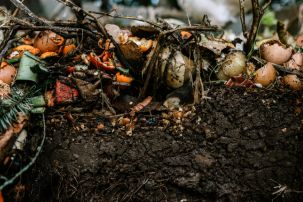Lesson summary
Students complete a biodiversity survey of their school’s compost bins They then collect data to determine how successful their school’s green waste is operating. Students make recommendations to their school community on improvements to the school’s composting system.
Learning intentions:
Students will...
- build an understanding of the different types of waste that is in their school
- create a classification key of compost creatures
- build skills in observation, data collection and the analysing of data.
Lesson guides and printables
Lesson details
Curriculum mapping
Australian curriculum content descriptions:
Year 7 Science:
- There are differences within and between groups of organisms; classification helps organise this diversity (ACSSU111)
- Interactions between organisms can be described in terms of food chains and food webs; human activity can affect these interactions (ACSSU112)
Syllabus Outcomes: SC4-14LW, SC4-15LW.
Time needed: 150 minutes.
Level of teacher scaffolding: Medium – students will need assistance in classifying the invertebrates found in a compost bin.
Resources required
- Low power microscopes
- Petrie dishes
- Icy-pole stick or similar for poking through compost samples
- Fresh moist compost samples
- Tablets or clip boards and writing materials
There’s an app for that: Home Composting for Organic Gardeners with Garden Organic.This app will show you how to make your own compost for free, helping you to feed and improve the soil condition.
Assumed prior learning: Students should be familiar with using low-powered microscopes. Have already done some work on classifying invertebrates. (This activity could be extended by using it as an introduction to invertebrate classification.)
Skills
This lesson is designed to build students’ competencies in the following skills:
- Critical thinking
- Collaboration
Additional info
Planet Ark’s National Recycling Week started in 1996 to bring a national focus to the environmental benefits of recycling. This highly regarded annual campaign continues to educate and stimulate behaviour change by promoting kerbside, industrial and community recycling initiative. It also gives people the tools to minimise waste and manage material resources responsibly at home, work and school. In partnership with Planet Ark, we have developed lessons from early learning through to year 10 to help educators bring these important topics into the classroom.
National Recycling Week is held in the second week of November each year but you can recycle all year-round with these lessons which were designed to be used at any time. Click here to find out more about National Recycling Week and the Schools Recycle Right Challenge.


Welcome back!
Don't have an account yet?
Log in with:
By signing up to Cool.org you consent and agree to Cool's privacy policy to
store, manage and process your personal information. To read more, please see
our privacy policy here(Opens in new tab).
Create your free Cool.org account.
Many of our resources are free, with an option to upgrade to Cool+ for premium content.
Already have an account?
Sign up with:
By signing up to Cool.org you consent and agree to Cool's privacy policy to
store, manage and process your personal information. To read more, please see
our privacy policy here(Opens in new tab).